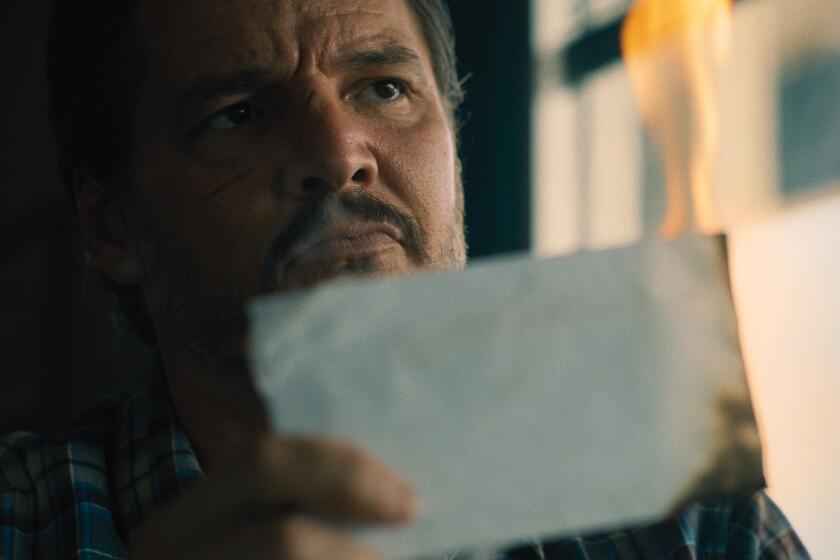Actor had a yin-yang quality
- Share via
As an actor, and possibly as a human being, David Carradine was a walking yin-yang symbol, a bundle of opposites tightly stitched together.
As a younger man, his lean, taut frame suggested both graceful self-possession and a capacity for explosive violence. Several of his best roles, both in film and television, cast him as a thinking-person’s action hero, poised in perpetual tension between contemplative inner peace and outward aggression and hostility.
In his most iconic role, Kwai Chang Caine, the philosophy-spouting, butt-kicking hero of ABC’s drama “Kung Fu” (1972-75), he played a half-Chinese man who was raised by Shaolin monks. On the lam in the American Old West, in search of his half-brother, Caine (like his biblical namesake) was a man divided against himself: a soft-spoken, flute-playing martial arts demon; a wandering loner who reached deep into prairie folks’ souls by uttering Zen-like paradoxes.
The show caught the tenor of its times. It arrived toward the tail-end of the hippie counterculture movement, when Americans were questioning “Establishment” authority and dabbling in Eastern mysticism, reading books such as Robert Pirsig’s novel, “Zen and the Art of Motorcycle Maintenance.” A year earlier, the cult film “Billy Jack” had fused karate-macho antics with the figure of a rebellious antihero.
Caine, a kind of bareheaded, bare-footed, 19th century beatnik poet, reflected a national mood of vague spiritual yearning, mixed with unease over the durability of Western values, and partially prompted by the United States’ dispiriting experience with the Vietnam War.
Three decades later, Quentin Tarantino would seize on Carradine’s dualistic (and dueling) star persona when he cast him as the title character in “Kill Bill.” The sprawling, two-part epic drew on Hong Kong martial arts movies and Italian spaghetti westerns, and was shaped by contrasting Eastern and Western notions of the aesthetics and metaphysics of violence.
The actor, who made more than 100 films over a more than 40-year career, was found dead on June 3 in his hotel room in Bangkok, where he had been on location shooting a movie. Details remain murky. Police reported that the actor had been found by a hotel maid, dead in a wardrobe with a rope around his neck and body. But Carradine’s manager said the actor had died of natural causes.
A member of the dynastic Carradine acting clan, which also includes family patriarch John Carradine and half-siblings Keith and Robert, David Carradine studied music and served in the Army before taking up stage acting. He landed his first bit-part film role in an adaptation of Louis L’Amour’s western novel “Taggart.”
Carradine’s rugged, hard-to-place features and his terse, sometimes laconic manner gave him the ability to be cast in roles as varied as Caine, folk troubadour Woody Guthrie in Hal Ashby’s “Bound for Glory” (1976), and as a renegade driver in Paul Bartel’s 1975 apocalyptic thriller “Death Race 2000,” which prefigured George Miller’s “Mad Max” films.
Destructive impulses, and the individual’s struggle to master them and bend them toward good, was a recurring motif in Carradine’s film and TV roles. Good men, in Carradine’s acting universe, may harbor brutal instincts and yield to primitive reflexes. Bad men, despite their flaws, may adhere to their own rigid, if twisted, codes of honor.
In Walter Hill’s 1980 western “The Long Riders,”, Carradine was cast with his brothers Keith and Robert as members of the outlaw Younger gang. The movie included a memorable scene in which Carradine squares off in a saloon knife fight, a riveting piece of cinematic choreography that invited viewers simply to enjoy the actor’s physicality and calculated stoicism.
Carradine could evince a very convincing, sinewy toughness, one that he used in other roles to memorable effect. Caine’s gently quizzical manner had been replaced by an insinuating, softly menacing voice and a hard stare. You wouldn’t want to mess with this guy.
Carradine’s martial arts proficiency was largely faked in “Kung Fu.” But the actor later took up these skills and even turned out a video series in martial arts training that he produced and starred in. In fact, Carradine dined out on this martial-arts-guru image for years, even deploying it for tongue-in-cheek television commercials. And while his resume kept growing, many of his late-career roles were forgettable lower-end features.
Married five times, Carradine had a personal life as volatile as any of his film roles. One reviewer described Carradine’s autobiography, “Endless Highway,” as a “dreary catalog of human disaster,” i.e. the actor’s own life. Characteristically candid in public -- sometimes disarmingly, sometimes abrasively -- he acknowledged struggling with both drug and alcohol abuse.
His complex nature flared up in public this spring during an American Cinematheque screening and discussion of “Bound for Glory,” at which Carradine got into an extended shouting match with audience members and Haskell Wexler, the esteemed cinematographer who won an Oscar for “Bound for Glory.” According to a lengthy account of the evening by entertainment writer Chris Willman, Carradine lashed out against labor unions and publicly berated Wexler for making “Bound for Glory” look too beautiful.
“I would have said, turn up the contrast, show the grit under the fingernails, don’t make any beauty about it, make it [expletive] ugly,” Willman quotes Carradine declaring to the stunned audience and the visibly (and understandably) infuriated Wexler.
Carradine will be remembered for his grittiness, to be sure, but also for imparting a certain strange beauty to ugly acts and dark arts.
--
More to Read
Only good movies
Get the Indie Focus newsletter, Mark Olsen's weekly guide to the world of cinema.
You may occasionally receive promotional content from the Los Angeles Times.









